Impact of International Trade, Finance, and Investment on Economies
VerifiedAdded on 2023/01/18
|13
|4304
|1
Report
AI Summary
This report provides a comprehensive analysis of international trade, finance, and investment, covering key aspects such as financial markets, capital allocation in both domestic and international economies, and the impact of organizations like the WTO. It delves into financial institutions, including debt and equity markets, and examines the role of central banks and monetary policies. The report explores economic theories like Ricardian trade theory and comparative advantage, and evaluates the growth of emerging economies, specifically focusing on China and the BRICS nations. It further discusses challenges related to industrialization and trade policies, offering insights into capital allocation systems, international investment methods, and the contributions of various organizations to international trade. The report aims to enhance understanding of global financial dynamics and economic development.
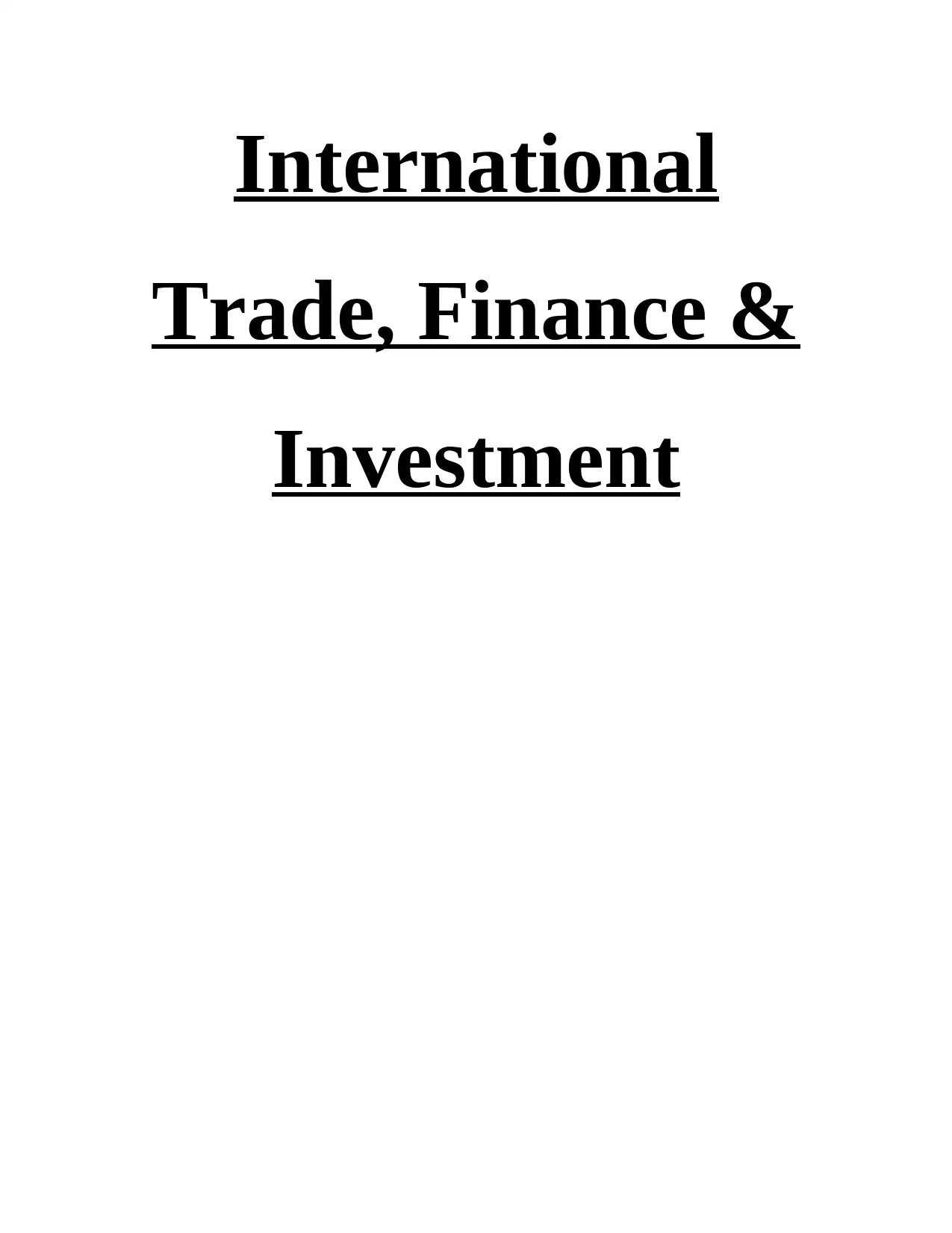
International
Trade, Finance &
Investment
Trade, Finance &
Investment
Paraphrase This Document
Need a fresh take? Get an instant paraphrase of this document with our AI Paraphraser
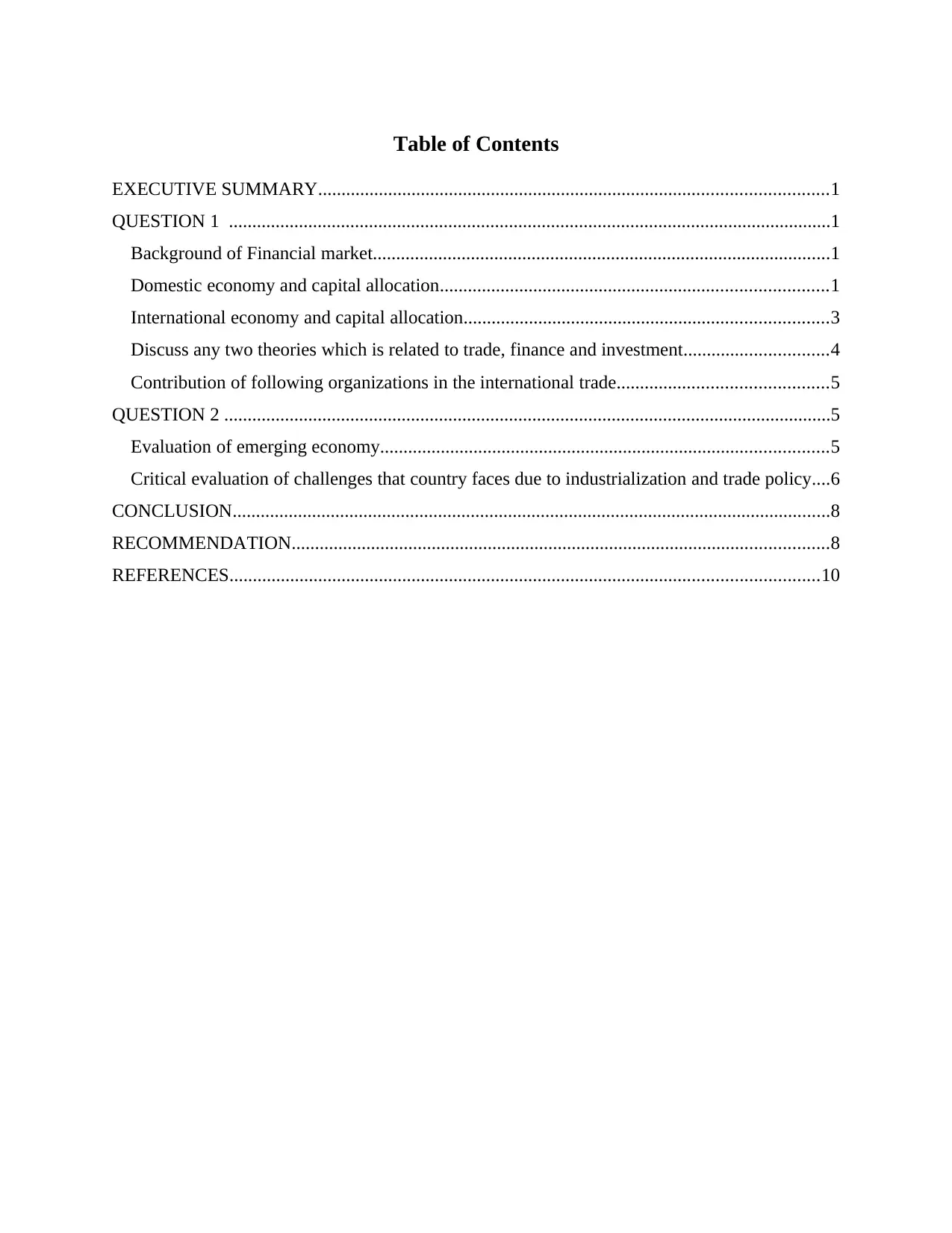
Table of Contents
EXECUTIVE SUMMARY.............................................................................................................1
QUESTION 1 .................................................................................................................................1
Background of Financial market..................................................................................................1
Domestic economy and capital allocation...................................................................................1
International economy and capital allocation..............................................................................3
Discuss any two theories which is related to trade, finance and investment...............................4
Contribution of following organizations in the international trade.............................................5
QUESTION 2 ..................................................................................................................................5
Evaluation of emerging economy................................................................................................5
Critical evaluation of challenges that country faces due to industrialization and trade policy....6
CONCLUSION................................................................................................................................8
RECOMMENDATION...................................................................................................................8
REFERENCES..............................................................................................................................10
EXECUTIVE SUMMARY.............................................................................................................1
QUESTION 1 .................................................................................................................................1
Background of Financial market..................................................................................................1
Domestic economy and capital allocation...................................................................................1
International economy and capital allocation..............................................................................3
Discuss any two theories which is related to trade, finance and investment...............................4
Contribution of following organizations in the international trade.............................................5
QUESTION 2 ..................................................................................................................................5
Evaluation of emerging economy................................................................................................5
Critical evaluation of challenges that country faces due to industrialization and trade policy....6
CONCLUSION................................................................................................................................8
RECOMMENDATION...................................................................................................................8
REFERENCES..............................................................................................................................10
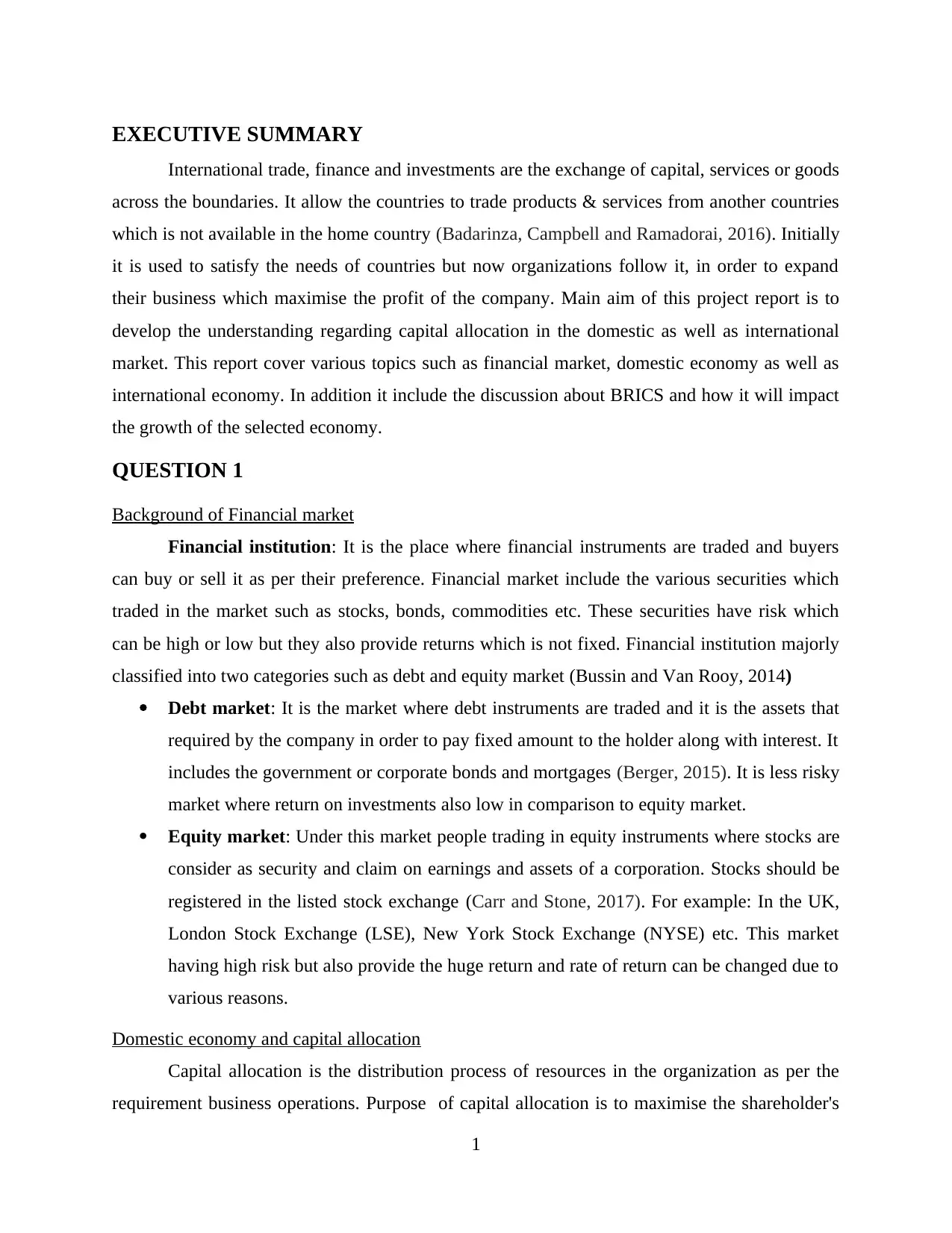
EXECUTIVE SUMMARY
International trade, finance and investments are the exchange of capital, services or goods
across the boundaries. It allow the countries to trade products & services from another countries
which is not available in the home country (Badarinza, Campbell and Ramadorai, 2016). Initially
it is used to satisfy the needs of countries but now organizations follow it, in order to expand
their business which maximise the profit of the company. Main aim of this project report is to
develop the understanding regarding capital allocation in the domestic as well as international
market. This report cover various topics such as financial market, domestic economy as well as
international economy. In addition it include the discussion about BRICS and how it will impact
the growth of the selected economy.
QUESTION 1
Background of Financial market
Financial institution: It is the place where financial instruments are traded and buyers
can buy or sell it as per their preference. Financial market include the various securities which
traded in the market such as stocks, bonds, commodities etc. These securities have risk which
can be high or low but they also provide returns which is not fixed. Financial institution majorly
classified into two categories such as debt and equity market (Bussin and Van Rooy, 2014)
Debt market: It is the market where debt instruments are traded and it is the assets that
required by the company in order to pay fixed amount to the holder along with interest. It
includes the government or corporate bonds and mortgages (Berger, 2015). It is less risky
market where return on investments also low in comparison to equity market.
Equity market: Under this market people trading in equity instruments where stocks are
consider as security and claim on earnings and assets of a corporation. Stocks should be
registered in the listed stock exchange (Carr and Stone, 2017). For example: In the UK,
London Stock Exchange (LSE), New York Stock Exchange (NYSE) etc. This market
having high risk but also provide the huge return and rate of return can be changed due to
various reasons.
Domestic economy and capital allocation
Capital allocation is the distribution process of resources in the organization as per the
requirement business operations. Purpose of capital allocation is to maximise the shareholder's
1
International trade, finance and investments are the exchange of capital, services or goods
across the boundaries. It allow the countries to trade products & services from another countries
which is not available in the home country (Badarinza, Campbell and Ramadorai, 2016). Initially
it is used to satisfy the needs of countries but now organizations follow it, in order to expand
their business which maximise the profit of the company. Main aim of this project report is to
develop the understanding regarding capital allocation in the domestic as well as international
market. This report cover various topics such as financial market, domestic economy as well as
international economy. In addition it include the discussion about BRICS and how it will impact
the growth of the selected economy.
QUESTION 1
Background of Financial market
Financial institution: It is the place where financial instruments are traded and buyers
can buy or sell it as per their preference. Financial market include the various securities which
traded in the market such as stocks, bonds, commodities etc. These securities have risk which
can be high or low but they also provide returns which is not fixed. Financial institution majorly
classified into two categories such as debt and equity market (Bussin and Van Rooy, 2014)
Debt market: It is the market where debt instruments are traded and it is the assets that
required by the company in order to pay fixed amount to the holder along with interest. It
includes the government or corporate bonds and mortgages (Berger, 2015). It is less risky
market where return on investments also low in comparison to equity market.
Equity market: Under this market people trading in equity instruments where stocks are
consider as security and claim on earnings and assets of a corporation. Stocks should be
registered in the listed stock exchange (Carr and Stone, 2017). For example: In the UK,
London Stock Exchange (LSE), New York Stock Exchange (NYSE) etc. This market
having high risk but also provide the huge return and rate of return can be changed due to
various reasons.
Domestic economy and capital allocation
Capital allocation is the distribution process of resources in the organization as per the
requirement business operations. Purpose of capital allocation is to maximise the shareholder's
1
⊘ This is a preview!⊘
Do you want full access?
Subscribe today to unlock all pages.

Trusted by 1+ million students worldwide
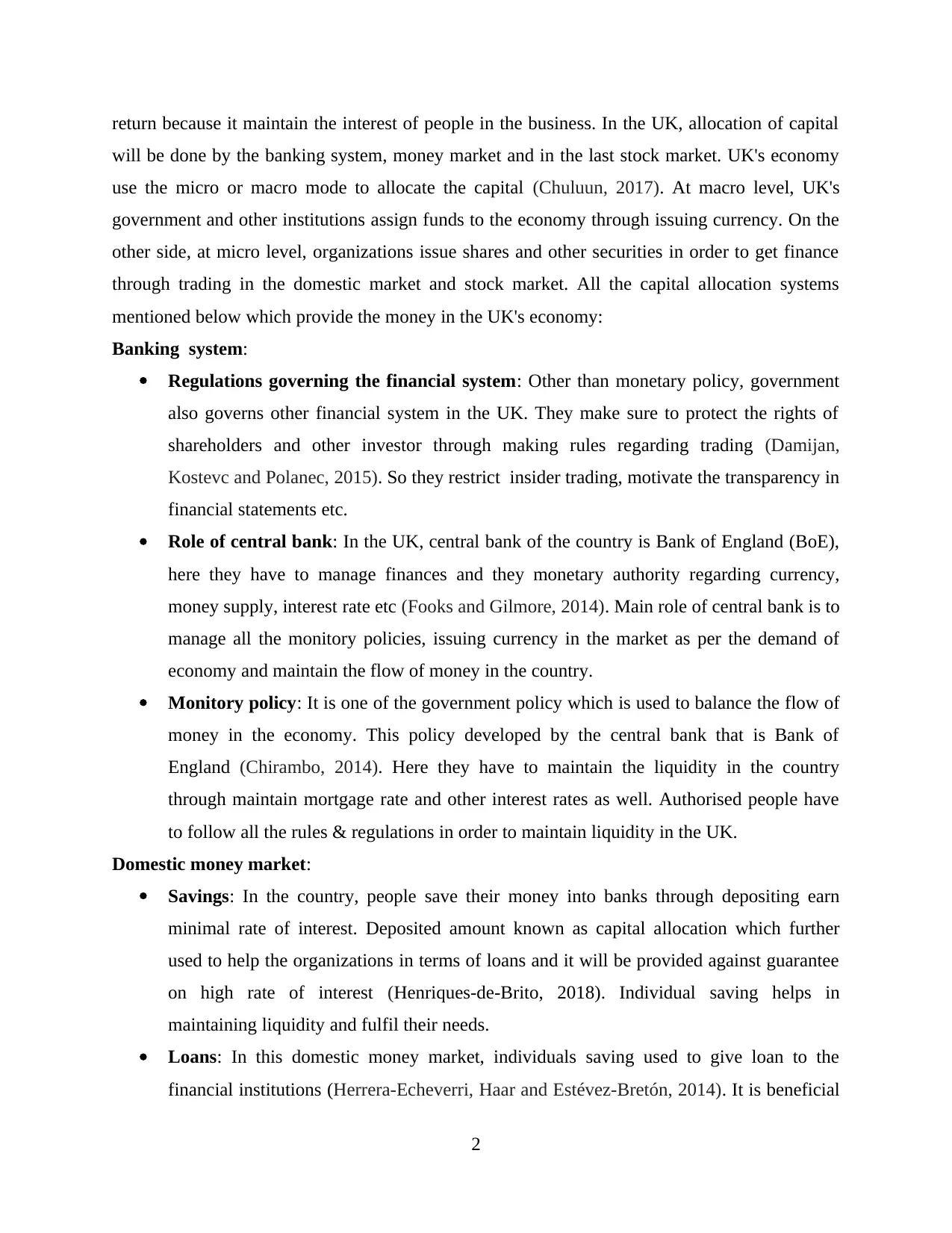
return because it maintain the interest of people in the business. In the UK, allocation of capital
will be done by the banking system, money market and in the last stock market. UK's economy
use the micro or macro mode to allocate the capital (Chuluun, 2017). At macro level, UK's
government and other institutions assign funds to the economy through issuing currency. On the
other side, at micro level, organizations issue shares and other securities in order to get finance
through trading in the domestic market and stock market. All the capital allocation systems
mentioned below which provide the money in the UK's economy:
Banking system:
Regulations governing the financial system: Other than monetary policy, government
also governs other financial system in the UK. They make sure to protect the rights of
shareholders and other investor through making rules regarding trading (Damijan,
Kostevc and Polanec, 2015). So they restrict insider trading, motivate the transparency in
financial statements etc.
Role of central bank: In the UK, central bank of the country is Bank of England (BoE),
here they have to manage finances and they monetary authority regarding currency,
money supply, interest rate etc (Fooks and Gilmore, 2014). Main role of central bank is to
manage all the monitory policies, issuing currency in the market as per the demand of
economy and maintain the flow of money in the country.
Monitory policy: It is one of the government policy which is used to balance the flow of
money in the economy. This policy developed by the central bank that is Bank of
England (Chirambo, 2014). Here they have to maintain the liquidity in the country
through maintain mortgage rate and other interest rates as well. Authorised people have
to follow all the rules & regulations in order to maintain liquidity in the UK.
Domestic money market:
Savings: In the country, people save their money into banks through depositing earn
minimal rate of interest. Deposited amount known as capital allocation which further
used to help the organizations in terms of loans and it will be provided against guarantee
on high rate of interest (Henriques-de-Brito, 2018). Individual saving helps in
maintaining liquidity and fulfil their needs.
Loans: In this domestic money market, individuals saving used to give loan to the
financial institutions (Herrera-Echeverri, Haar and Estévez-Bretón, 2014). It is beneficial
2
will be done by the banking system, money market and in the last stock market. UK's economy
use the micro or macro mode to allocate the capital (Chuluun, 2017). At macro level, UK's
government and other institutions assign funds to the economy through issuing currency. On the
other side, at micro level, organizations issue shares and other securities in order to get finance
through trading in the domestic market and stock market. All the capital allocation systems
mentioned below which provide the money in the UK's economy:
Banking system:
Regulations governing the financial system: Other than monetary policy, government
also governs other financial system in the UK. They make sure to protect the rights of
shareholders and other investor through making rules regarding trading (Damijan,
Kostevc and Polanec, 2015). So they restrict insider trading, motivate the transparency in
financial statements etc.
Role of central bank: In the UK, central bank of the country is Bank of England (BoE),
here they have to manage finances and they monetary authority regarding currency,
money supply, interest rate etc (Fooks and Gilmore, 2014). Main role of central bank is to
manage all the monitory policies, issuing currency in the market as per the demand of
economy and maintain the flow of money in the country.
Monitory policy: It is one of the government policy which is used to balance the flow of
money in the economy. This policy developed by the central bank that is Bank of
England (Chirambo, 2014). Here they have to maintain the liquidity in the country
through maintain mortgage rate and other interest rates as well. Authorised people have
to follow all the rules & regulations in order to maintain liquidity in the UK.
Domestic money market:
Savings: In the country, people save their money into banks through depositing earn
minimal rate of interest. Deposited amount known as capital allocation which further
used to help the organizations in terms of loans and it will be provided against guarantee
on high rate of interest (Henriques-de-Brito, 2018). Individual saving helps in
maintaining liquidity and fulfil their needs.
Loans: In this domestic money market, individuals saving used to give loan to the
financial institutions (Herrera-Echeverri, Haar and Estévez-Bretón, 2014). It is beneficial
2
Paraphrase This Document
Need a fresh take? Get an instant paraphrase of this document with our AI Paraphraser
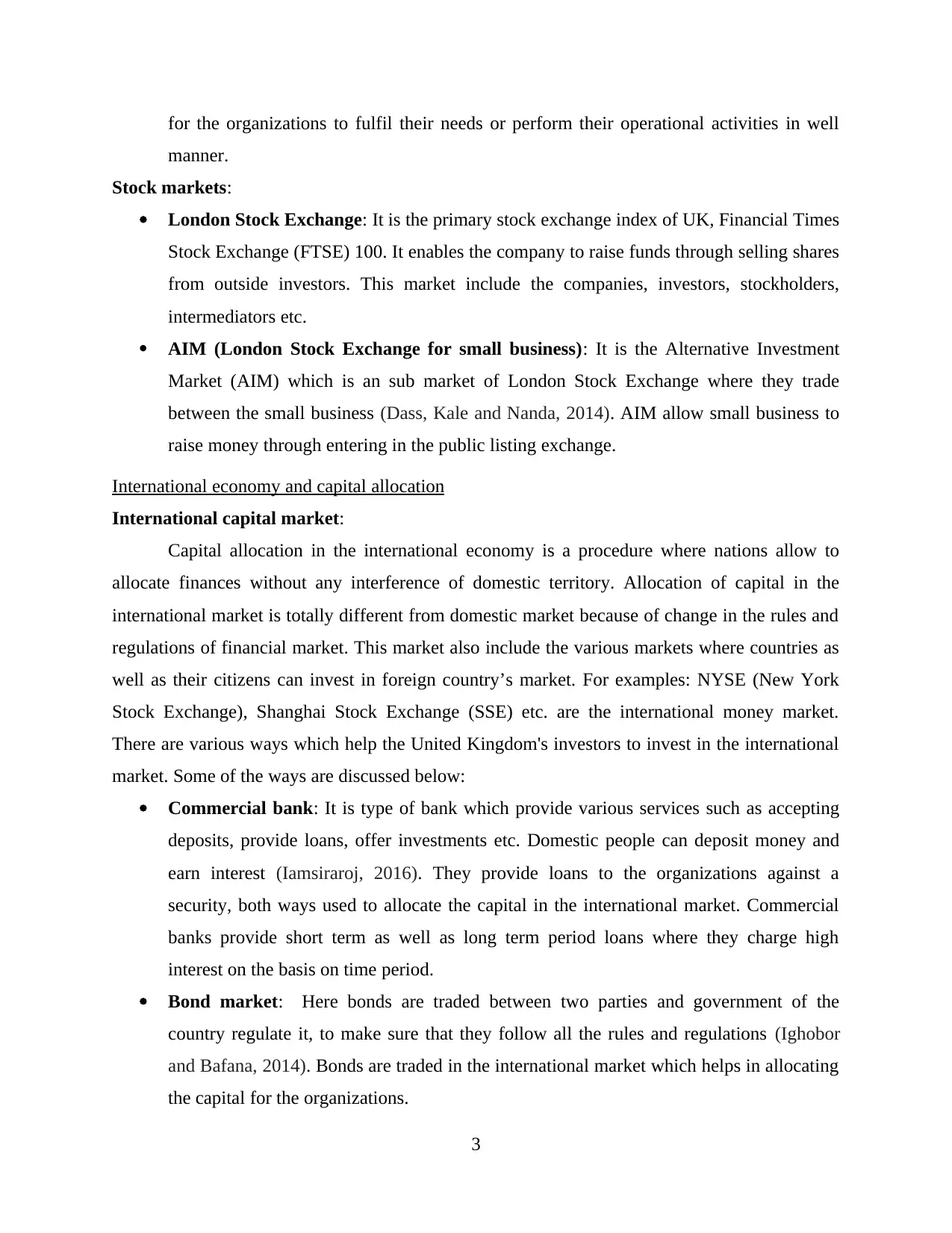
for the organizations to fulfil their needs or perform their operational activities in well
manner.
Stock markets:
London Stock Exchange: It is the primary stock exchange index of UK, Financial Times
Stock Exchange (FTSE) 100. It enables the company to raise funds through selling shares
from outside investors. This market include the companies, investors, stockholders,
intermediators etc.
AIM (London Stock Exchange for small business): It is the Alternative Investment
Market (AIM) which is an sub market of London Stock Exchange where they trade
between the small business (Dass, Kale and Nanda, 2014). AIM allow small business to
raise money through entering in the public listing exchange.
International economy and capital allocation
International capital market:
Capital allocation in the international economy is a procedure where nations allow to
allocate finances without any interference of domestic territory. Allocation of capital in the
international market is totally different from domestic market because of change in the rules and
regulations of financial market. This market also include the various markets where countries as
well as their citizens can invest in foreign country’s market. For examples: NYSE (New York
Stock Exchange), Shanghai Stock Exchange (SSE) etc. are the international money market.
There are various ways which help the United Kingdom's investors to invest in the international
market. Some of the ways are discussed below:
Commercial bank: It is type of bank which provide various services such as accepting
deposits, provide loans, offer investments etc. Domestic people can deposit money and
earn interest (Iamsiraroj, 2016). They provide loans to the organizations against a
security, both ways used to allocate the capital in the international market. Commercial
banks provide short term as well as long term period loans where they charge high
interest on the basis on time period.
Bond market: Here bonds are traded between two parties and government of the
country regulate it, to make sure that they follow all the rules and regulations (Ighobor
and Bafana, 2014). Bonds are traded in the international market which helps in allocating
the capital for the organizations.
3
manner.
Stock markets:
London Stock Exchange: It is the primary stock exchange index of UK, Financial Times
Stock Exchange (FTSE) 100. It enables the company to raise funds through selling shares
from outside investors. This market include the companies, investors, stockholders,
intermediators etc.
AIM (London Stock Exchange for small business): It is the Alternative Investment
Market (AIM) which is an sub market of London Stock Exchange where they trade
between the small business (Dass, Kale and Nanda, 2014). AIM allow small business to
raise money through entering in the public listing exchange.
International economy and capital allocation
International capital market:
Capital allocation in the international economy is a procedure where nations allow to
allocate finances without any interference of domestic territory. Allocation of capital in the
international market is totally different from domestic market because of change in the rules and
regulations of financial market. This market also include the various markets where countries as
well as their citizens can invest in foreign country’s market. For examples: NYSE (New York
Stock Exchange), Shanghai Stock Exchange (SSE) etc. are the international money market.
There are various ways which help the United Kingdom's investors to invest in the international
market. Some of the ways are discussed below:
Commercial bank: It is type of bank which provide various services such as accepting
deposits, provide loans, offer investments etc. Domestic people can deposit money and
earn interest (Iamsiraroj, 2016). They provide loans to the organizations against a
security, both ways used to allocate the capital in the international market. Commercial
banks provide short term as well as long term period loans where they charge high
interest on the basis on time period.
Bond market: Here bonds are traded between two parties and government of the
country regulate it, to make sure that they follow all the rules and regulations (Ighobor
and Bafana, 2014). Bonds are traded in the international market which helps in allocating
the capital for the organizations.
3
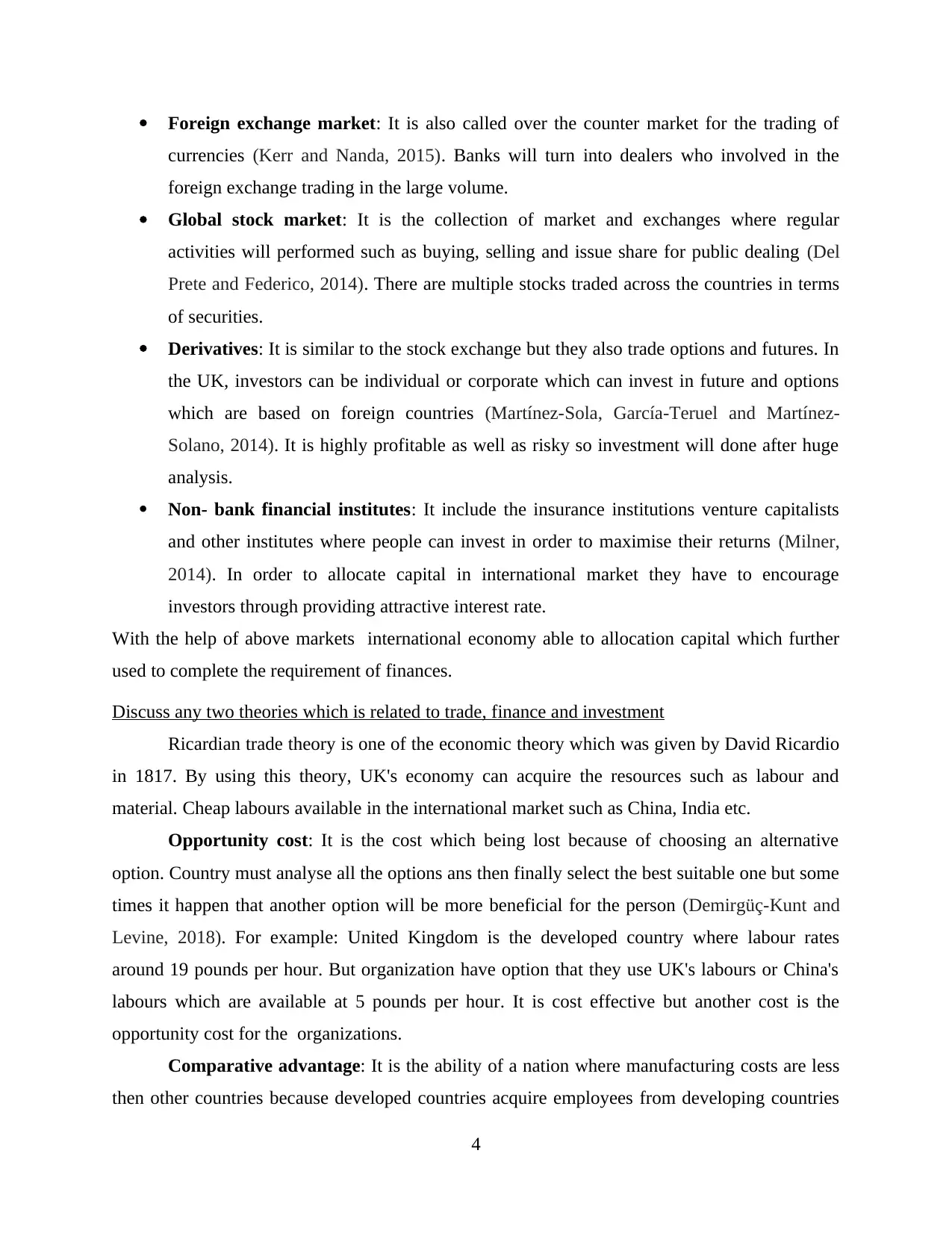
Foreign exchange market: It is also called over the counter market for the trading of
currencies (Kerr and Nanda, 2015). Banks will turn into dealers who involved in the
foreign exchange trading in the large volume.
Global stock market: It is the collection of market and exchanges where regular
activities will performed such as buying, selling and issue share for public dealing (Del
Prete and Federico, 2014). There are multiple stocks traded across the countries in terms
of securities.
Derivatives: It is similar to the stock exchange but they also trade options and futures. In
the UK, investors can be individual or corporate which can invest in future and options
which are based on foreign countries (Martínez-Sola, García-Teruel and Martínez-
Solano, 2014). It is highly profitable as well as risky so investment will done after huge
analysis.
Non- bank financial institutes: It include the insurance institutions venture capitalists
and other institutes where people can invest in order to maximise their returns (Milner,
2014). In order to allocate capital in international market they have to encourage
investors through providing attractive interest rate.
With the help of above markets international economy able to allocation capital which further
used to complete the requirement of finances.
Discuss any two theories which is related to trade, finance and investment
Ricardian trade theory is one of the economic theory which was given by David Ricardio
in 1817. By using this theory, UK's economy can acquire the resources such as labour and
material. Cheap labours available in the international market such as China, India etc.
Opportunity cost: It is the cost which being lost because of choosing an alternative
option. Country must analyse all the options ans then finally select the best suitable one but some
times it happen that another option will be more beneficial for the person (Demirgüç-Kunt and
Levine, 2018). For example: United Kingdom is the developed country where labour rates
around 19 pounds per hour. But organization have option that they use UK's labours or China's
labours which are available at 5 pounds per hour. It is cost effective but another cost is the
opportunity cost for the organizations.
Comparative advantage: It is the ability of a nation where manufacturing costs are less
then other countries because developed countries acquire employees from developing countries
4
currencies (Kerr and Nanda, 2015). Banks will turn into dealers who involved in the
foreign exchange trading in the large volume.
Global stock market: It is the collection of market and exchanges where regular
activities will performed such as buying, selling and issue share for public dealing (Del
Prete and Federico, 2014). There are multiple stocks traded across the countries in terms
of securities.
Derivatives: It is similar to the stock exchange but they also trade options and futures. In
the UK, investors can be individual or corporate which can invest in future and options
which are based on foreign countries (Martínez-Sola, García-Teruel and Martínez-
Solano, 2014). It is highly profitable as well as risky so investment will done after huge
analysis.
Non- bank financial institutes: It include the insurance institutions venture capitalists
and other institutes where people can invest in order to maximise their returns (Milner,
2014). In order to allocate capital in international market they have to encourage
investors through providing attractive interest rate.
With the help of above markets international economy able to allocation capital which further
used to complete the requirement of finances.
Discuss any two theories which is related to trade, finance and investment
Ricardian trade theory is one of the economic theory which was given by David Ricardio
in 1817. By using this theory, UK's economy can acquire the resources such as labour and
material. Cheap labours available in the international market such as China, India etc.
Opportunity cost: It is the cost which being lost because of choosing an alternative
option. Country must analyse all the options ans then finally select the best suitable one but some
times it happen that another option will be more beneficial for the person (Demirgüç-Kunt and
Levine, 2018). For example: United Kingdom is the developed country where labour rates
around 19 pounds per hour. But organization have option that they use UK's labours or China's
labours which are available at 5 pounds per hour. It is cost effective but another cost is the
opportunity cost for the organizations.
Comparative advantage: It is the ability of a nation where manufacturing costs are less
then other countries because developed countries acquire employees from developing countries
4
⊘ This is a preview!⊘
Do you want full access?
Subscribe today to unlock all pages.

Trusted by 1+ million students worldwide
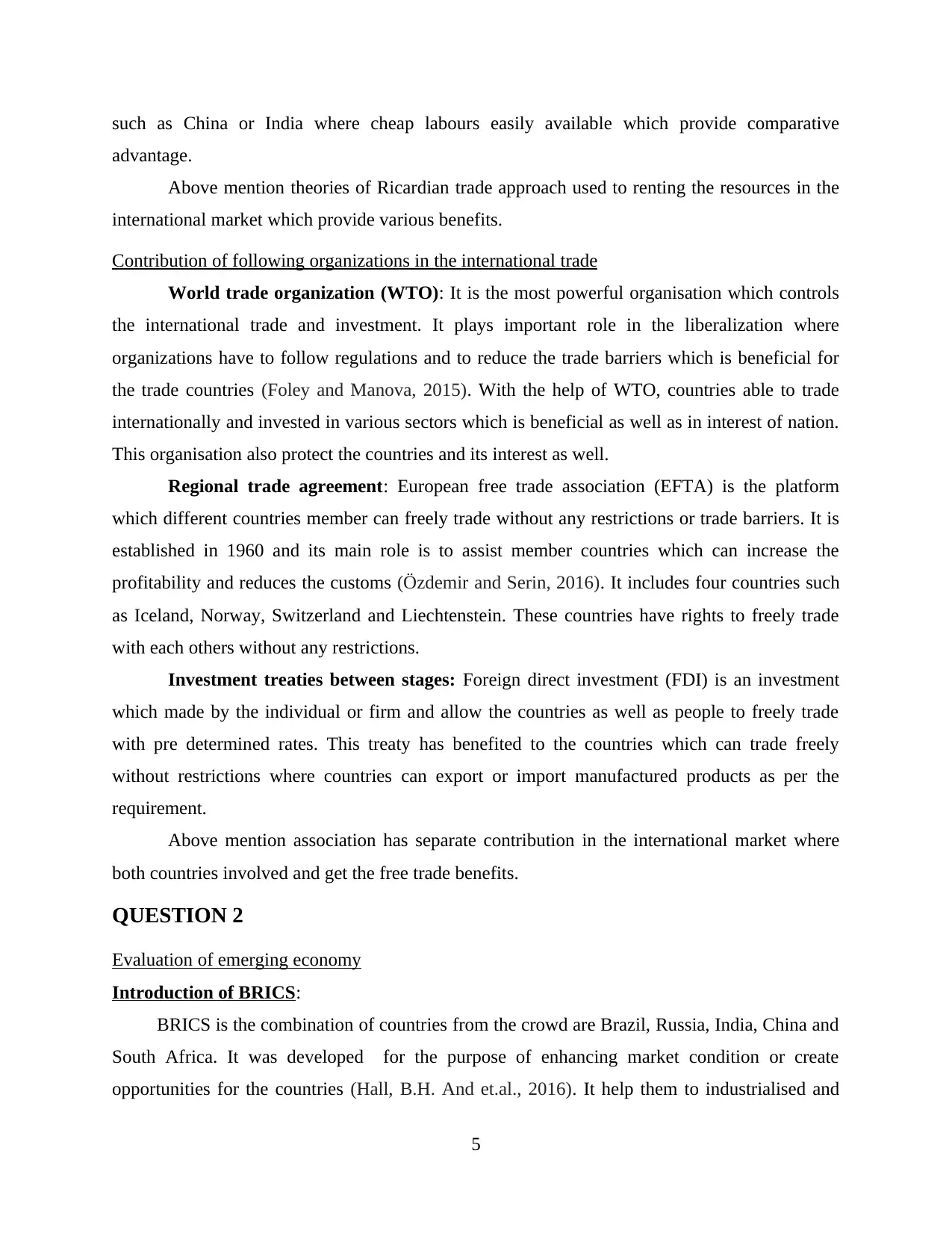
such as China or India where cheap labours easily available which provide comparative
advantage.
Above mention theories of Ricardian trade approach used to renting the resources in the
international market which provide various benefits.
Contribution of following organizations in the international trade
World trade organization (WTO): It is the most powerful organisation which controls
the international trade and investment. It plays important role in the liberalization where
organizations have to follow regulations and to reduce the trade barriers which is beneficial for
the trade countries (Foley and Manova, 2015). With the help of WTO, countries able to trade
internationally and invested in various sectors which is beneficial as well as in interest of nation.
This organisation also protect the countries and its interest as well.
Regional trade agreement: European free trade association (EFTA) is the platform
which different countries member can freely trade without any restrictions or trade barriers. It is
established in 1960 and its main role is to assist member countries which can increase the
profitability and reduces the customs (Özdemir and Serin, 2016). It includes four countries such
as Iceland, Norway, Switzerland and Liechtenstein. These countries have rights to freely trade
with each others without any restrictions.
Investment treaties between stages: Foreign direct investment (FDI) is an investment
which made by the individual or firm and allow the countries as well as people to freely trade
with pre determined rates. This treaty has benefited to the countries which can trade freely
without restrictions where countries can export or import manufactured products as per the
requirement.
Above mention association has separate contribution in the international market where
both countries involved and get the free trade benefits.
QUESTION 2
Evaluation of emerging economy
Introduction of BRICS:
BRICS is the combination of countries from the crowd are Brazil, Russia, India, China and
South Africa. It was developed for the purpose of enhancing market condition or create
opportunities for the countries (Hall, B.H. And et.al., 2016). It help them to industrialised and
5
advantage.
Above mention theories of Ricardian trade approach used to renting the resources in the
international market which provide various benefits.
Contribution of following organizations in the international trade
World trade organization (WTO): It is the most powerful organisation which controls
the international trade and investment. It plays important role in the liberalization where
organizations have to follow regulations and to reduce the trade barriers which is beneficial for
the trade countries (Foley and Manova, 2015). With the help of WTO, countries able to trade
internationally and invested in various sectors which is beneficial as well as in interest of nation.
This organisation also protect the countries and its interest as well.
Regional trade agreement: European free trade association (EFTA) is the platform
which different countries member can freely trade without any restrictions or trade barriers. It is
established in 1960 and its main role is to assist member countries which can increase the
profitability and reduces the customs (Özdemir and Serin, 2016). It includes four countries such
as Iceland, Norway, Switzerland and Liechtenstein. These countries have rights to freely trade
with each others without any restrictions.
Investment treaties between stages: Foreign direct investment (FDI) is an investment
which made by the individual or firm and allow the countries as well as people to freely trade
with pre determined rates. This treaty has benefited to the countries which can trade freely
without restrictions where countries can export or import manufactured products as per the
requirement.
Above mention association has separate contribution in the international market where
both countries involved and get the free trade benefits.
QUESTION 2
Evaluation of emerging economy
Introduction of BRICS:
BRICS is the combination of countries from the crowd are Brazil, Russia, India, China and
South Africa. It was developed for the purpose of enhancing market condition or create
opportunities for the countries (Hall, B.H. And et.al., 2016). It help them to industrialised and
5
Paraphrase This Document
Need a fresh take? Get an instant paraphrase of this document with our AI Paraphraser
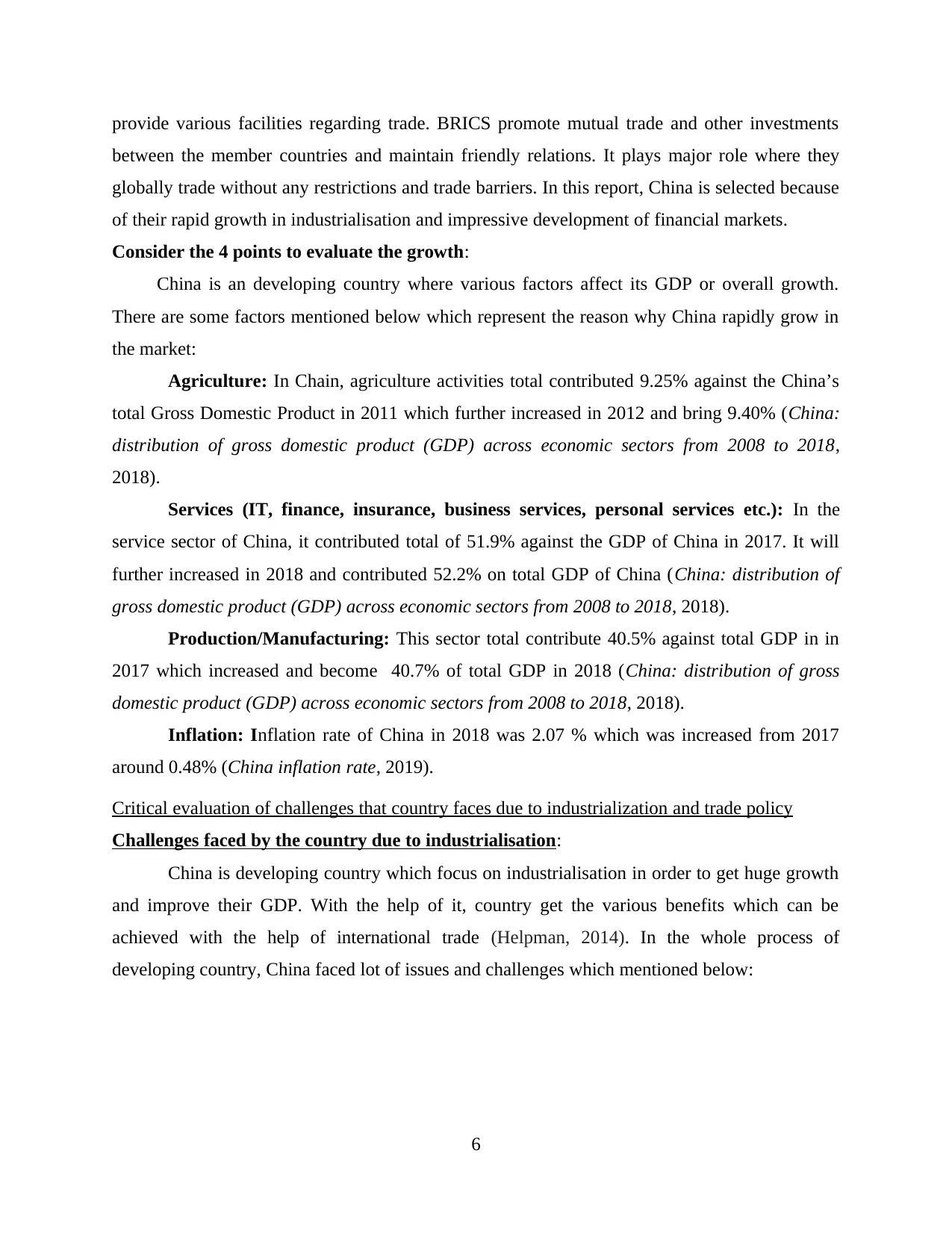
provide various facilities regarding trade. BRICS promote mutual trade and other investments
between the member countries and maintain friendly relations. It plays major role where they
globally trade without any restrictions and trade barriers. In this report, China is selected because
of their rapid growth in industrialisation and impressive development of financial markets.
Consider the 4 points to evaluate the growth:
China is an developing country where various factors affect its GDP or overall growth.
There are some factors mentioned below which represent the reason why China rapidly grow in
the market:
Agriculture: In Chain, agriculture activities total contributed 9.25% against the China’s
total Gross Domestic Product in 2011 which further increased in 2012 and bring 9.40% (China:
distribution of gross domestic product (GDP) across economic sectors from 2008 to 2018,
2018).
Services (IT, finance, insurance, business services, personal services etc.): In the
service sector of China, it contributed total of 51.9% against the GDP of China in 2017. It will
further increased in 2018 and contributed 52.2% on total GDP of China (China: distribution of
gross domestic product (GDP) across economic sectors from 2008 to 2018, 2018).
Production/Manufacturing: This sector total contribute 40.5% against total GDP in in
2017 which increased and become 40.7% of total GDP in 2018 (China: distribution of gross
domestic product (GDP) across economic sectors from 2008 to 2018, 2018).
Inflation: Inflation rate of China in 2018 was 2.07 % which was increased from 2017
around 0.48% (China inflation rate, 2019).
Critical evaluation of challenges that country faces due to industrialization and trade policy
Challenges faced by the country due to industrialisation:
China is developing country which focus on industrialisation in order to get huge growth
and improve their GDP. With the help of it, country get the various benefits which can be
achieved with the help of international trade (Helpman, 2014). In the whole process of
developing country, China faced lot of issues and challenges which mentioned below:
6
between the member countries and maintain friendly relations. It plays major role where they
globally trade without any restrictions and trade barriers. In this report, China is selected because
of their rapid growth in industrialisation and impressive development of financial markets.
Consider the 4 points to evaluate the growth:
China is an developing country where various factors affect its GDP or overall growth.
There are some factors mentioned below which represent the reason why China rapidly grow in
the market:
Agriculture: In Chain, agriculture activities total contributed 9.25% against the China’s
total Gross Domestic Product in 2011 which further increased in 2012 and bring 9.40% (China:
distribution of gross domestic product (GDP) across economic sectors from 2008 to 2018,
2018).
Services (IT, finance, insurance, business services, personal services etc.): In the
service sector of China, it contributed total of 51.9% against the GDP of China in 2017. It will
further increased in 2018 and contributed 52.2% on total GDP of China (China: distribution of
gross domestic product (GDP) across economic sectors from 2008 to 2018, 2018).
Production/Manufacturing: This sector total contribute 40.5% against total GDP in in
2017 which increased and become 40.7% of total GDP in 2018 (China: distribution of gross
domestic product (GDP) across economic sectors from 2008 to 2018, 2018).
Inflation: Inflation rate of China in 2018 was 2.07 % which was increased from 2017
around 0.48% (China inflation rate, 2019).
Critical evaluation of challenges that country faces due to industrialization and trade policy
Challenges faced by the country due to industrialisation:
China is developing country which focus on industrialisation in order to get huge growth
and improve their GDP. With the help of it, country get the various benefits which can be
achieved with the help of international trade (Helpman, 2014). In the whole process of
developing country, China faced lot of issues and challenges which mentioned below:
6
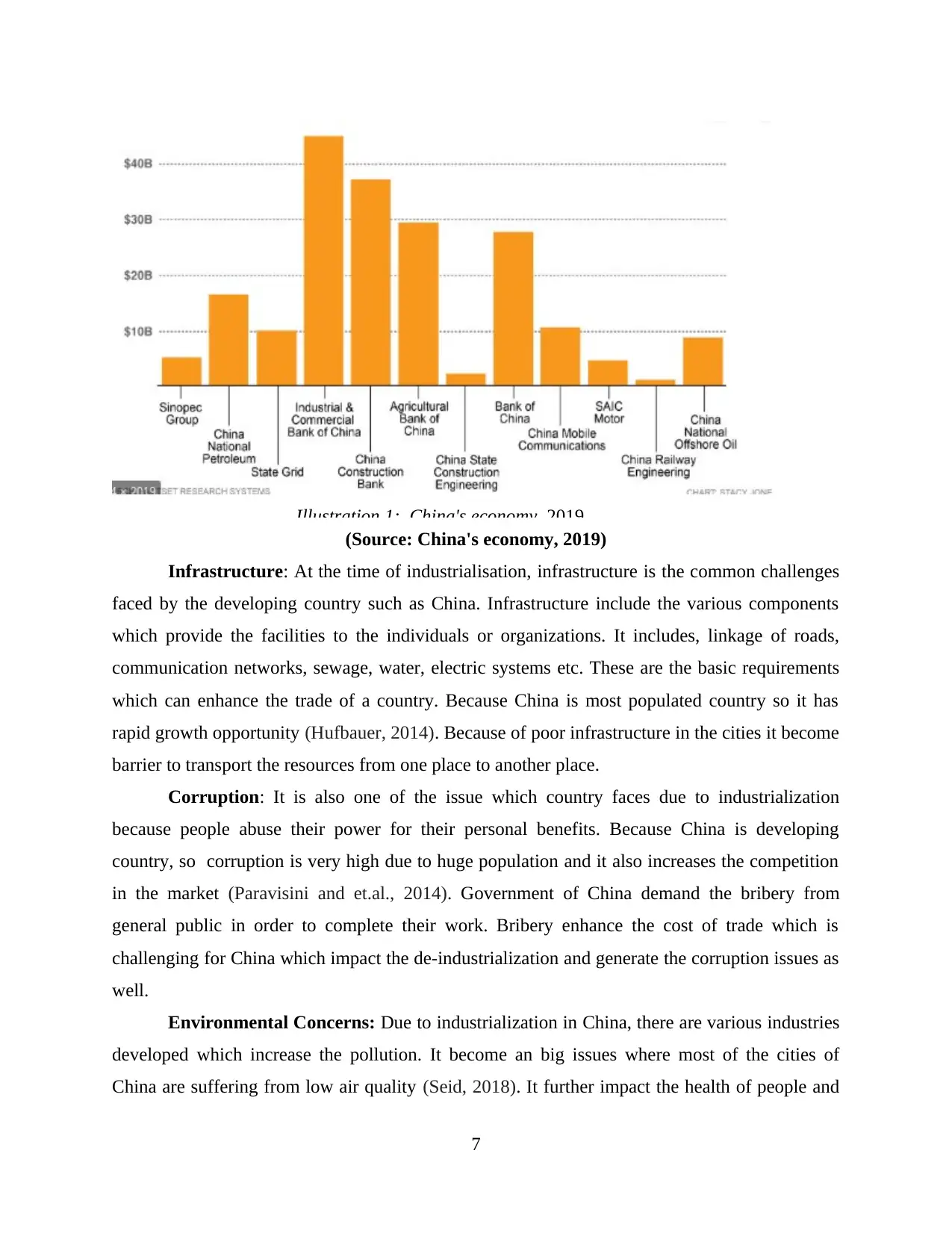
Illustration 1: China's economy, 2019.
(Source: China's economy, 2019)
Infrastructure: At the time of industrialisation, infrastructure is the common challenges
faced by the developing country such as China. Infrastructure include the various components
which provide the facilities to the individuals or organizations. It includes, linkage of roads,
communication networks, sewage, water, electric systems etc. These are the basic requirements
which can enhance the trade of a country. Because China is most populated country so it has
rapid growth opportunity (Hufbauer, 2014). Because of poor infrastructure in the cities it become
barrier to transport the resources from one place to another place.
Corruption: It is also one of the issue which country faces due to industrialization
because people abuse their power for their personal benefits. Because China is developing
country, so corruption is very high due to huge population and it also increases the competition
in the market (Paravisini and et.al., 2014). Government of China demand the bribery from
general public in order to complete their work. Bribery enhance the cost of trade which is
challenging for China which impact the de-industrialization and generate the corruption issues as
well.
Environmental Concerns: Due to industrialization in China, there are various industries
developed which increase the pollution. It become an big issues where most of the cities of
China are suffering from low air quality (Seid, 2018). It further impact the health of people and
7
(Source: China's economy, 2019)
Infrastructure: At the time of industrialisation, infrastructure is the common challenges
faced by the developing country such as China. Infrastructure include the various components
which provide the facilities to the individuals or organizations. It includes, linkage of roads,
communication networks, sewage, water, electric systems etc. These are the basic requirements
which can enhance the trade of a country. Because China is most populated country so it has
rapid growth opportunity (Hufbauer, 2014). Because of poor infrastructure in the cities it become
barrier to transport the resources from one place to another place.
Corruption: It is also one of the issue which country faces due to industrialization
because people abuse their power for their personal benefits. Because China is developing
country, so corruption is very high due to huge population and it also increases the competition
in the market (Paravisini and et.al., 2014). Government of China demand the bribery from
general public in order to complete their work. Bribery enhance the cost of trade which is
challenging for China which impact the de-industrialization and generate the corruption issues as
well.
Environmental Concerns: Due to industrialization in China, there are various industries
developed which increase the pollution. It become an big issues where most of the cities of
China are suffering from low air quality (Seid, 2018). It further impact the health of people and
7
⊘ This is a preview!⊘
Do you want full access?
Subscribe today to unlock all pages.

Trusted by 1+ million students worldwide
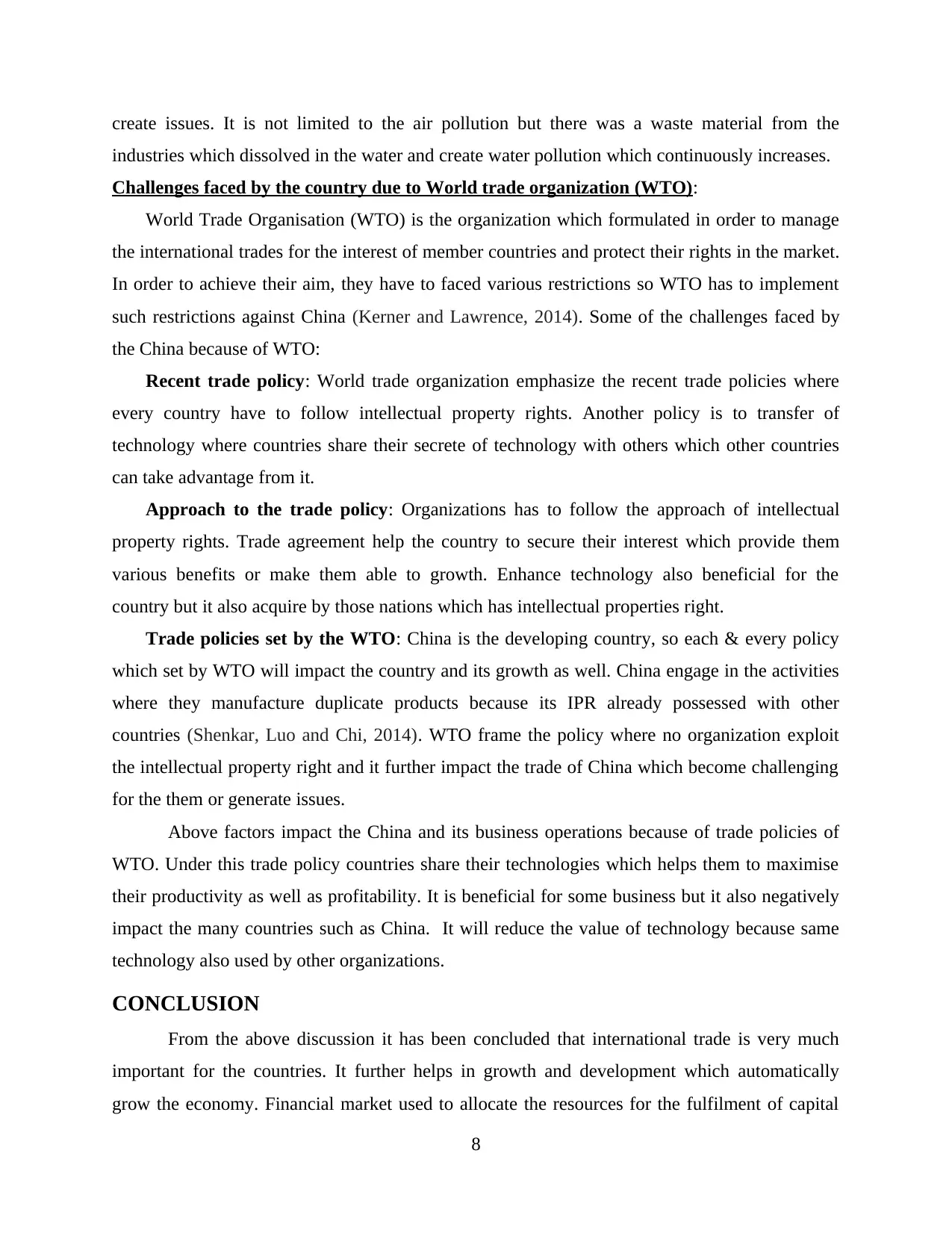
create issues. It is not limited to the air pollution but there was a waste material from the
industries which dissolved in the water and create water pollution which continuously increases.
Challenges faced by the country due to World trade organization (WTO):
World Trade Organisation (WTO) is the organization which formulated in order to manage
the international trades for the interest of member countries and protect their rights in the market.
In order to achieve their aim, they have to faced various restrictions so WTO has to implement
such restrictions against China (Kerner and Lawrence, 2014). Some of the challenges faced by
the China because of WTO:
Recent trade policy: World trade organization emphasize the recent trade policies where
every country have to follow intellectual property rights. Another policy is to transfer of
technology where countries share their secrete of technology with others which other countries
can take advantage from it.
Approach to the trade policy: Organizations has to follow the approach of intellectual
property rights. Trade agreement help the country to secure their interest which provide them
various benefits or make them able to growth. Enhance technology also beneficial for the
country but it also acquire by those nations which has intellectual properties right.
Trade policies set by the WTO: China is the developing country, so each & every policy
which set by WTO will impact the country and its growth as well. China engage in the activities
where they manufacture duplicate products because its IPR already possessed with other
countries (Shenkar, Luo and Chi, 2014). WTO frame the policy where no organization exploit
the intellectual property right and it further impact the trade of China which become challenging
for the them or generate issues.
Above factors impact the China and its business operations because of trade policies of
WTO. Under this trade policy countries share their technologies which helps them to maximise
their productivity as well as profitability. It is beneficial for some business but it also negatively
impact the many countries such as China. It will reduce the value of technology because same
technology also used by other organizations.
CONCLUSION
From the above discussion it has been concluded that international trade is very much
important for the countries. It further helps in growth and development which automatically
grow the economy. Financial market used to allocate the resources for the fulfilment of capital
8
industries which dissolved in the water and create water pollution which continuously increases.
Challenges faced by the country due to World trade organization (WTO):
World Trade Organisation (WTO) is the organization which formulated in order to manage
the international trades for the interest of member countries and protect their rights in the market.
In order to achieve their aim, they have to faced various restrictions so WTO has to implement
such restrictions against China (Kerner and Lawrence, 2014). Some of the challenges faced by
the China because of WTO:
Recent trade policy: World trade organization emphasize the recent trade policies where
every country have to follow intellectual property rights. Another policy is to transfer of
technology where countries share their secrete of technology with others which other countries
can take advantage from it.
Approach to the trade policy: Organizations has to follow the approach of intellectual
property rights. Trade agreement help the country to secure their interest which provide them
various benefits or make them able to growth. Enhance technology also beneficial for the
country but it also acquire by those nations which has intellectual properties right.
Trade policies set by the WTO: China is the developing country, so each & every policy
which set by WTO will impact the country and its growth as well. China engage in the activities
where they manufacture duplicate products because its IPR already possessed with other
countries (Shenkar, Luo and Chi, 2014). WTO frame the policy where no organization exploit
the intellectual property right and it further impact the trade of China which become challenging
for the them or generate issues.
Above factors impact the China and its business operations because of trade policies of
WTO. Under this trade policy countries share their technologies which helps them to maximise
their productivity as well as profitability. It is beneficial for some business but it also negatively
impact the many countries such as China. It will reduce the value of technology because same
technology also used by other organizations.
CONCLUSION
From the above discussion it has been concluded that international trade is very much
important for the countries. It further helps in growth and development which automatically
grow the economy. Financial market used to allocate the resources for the fulfilment of capital
8
Paraphrase This Document
Need a fresh take? Get an instant paraphrase of this document with our AI Paraphraser
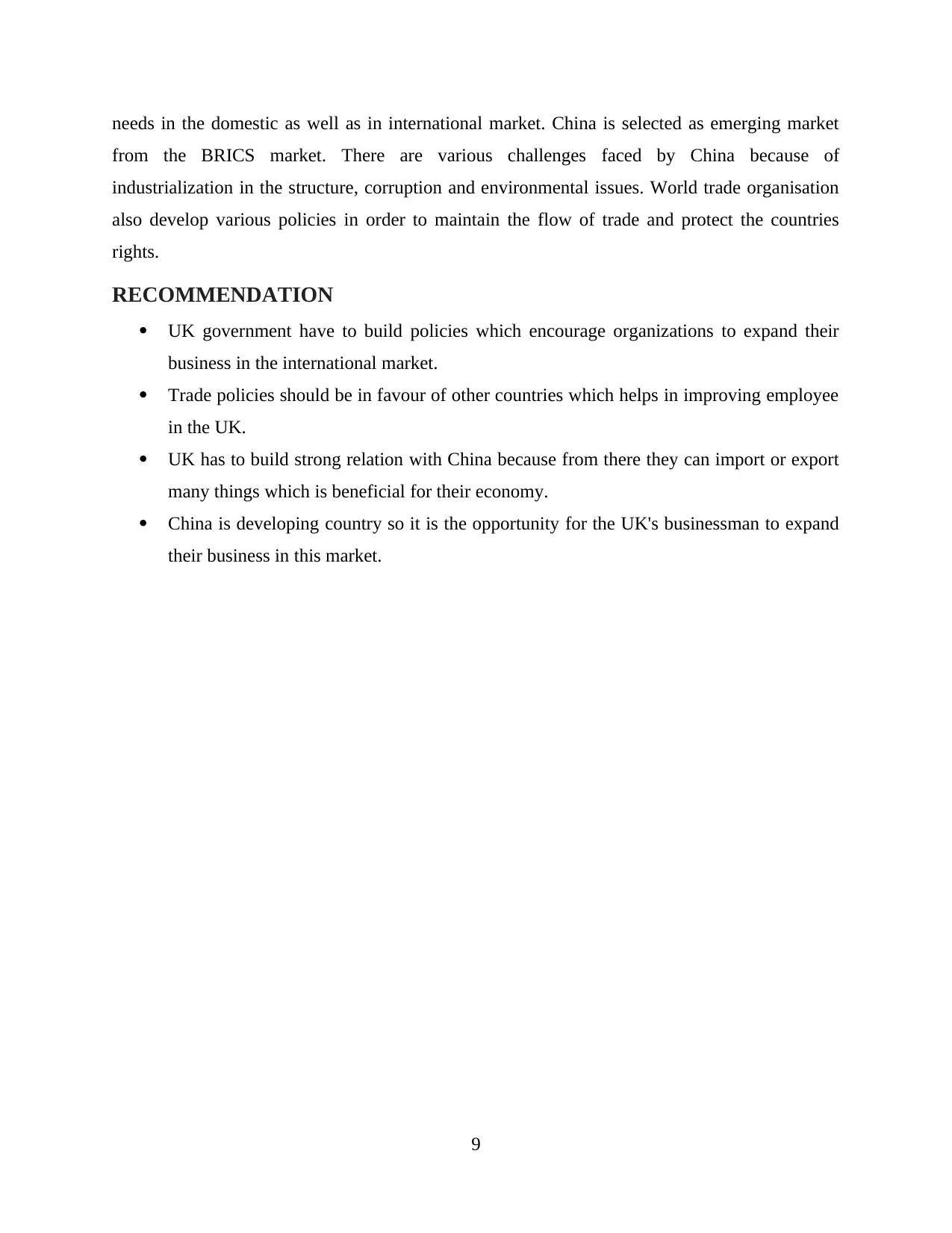
needs in the domestic as well as in international market. China is selected as emerging market
from the BRICS market. There are various challenges faced by China because of
industrialization in the structure, corruption and environmental issues. World trade organisation
also develop various policies in order to maintain the flow of trade and protect the countries
rights.
RECOMMENDATION
UK government have to build policies which encourage organizations to expand their
business in the international market.
Trade policies should be in favour of other countries which helps in improving employee
in the UK.
UK has to build strong relation with China because from there they can import or export
many things which is beneficial for their economy.
China is developing country so it is the opportunity for the UK's businessman to expand
their business in this market.
9
from the BRICS market. There are various challenges faced by China because of
industrialization in the structure, corruption and environmental issues. World trade organisation
also develop various policies in order to maintain the flow of trade and protect the countries
rights.
RECOMMENDATION
UK government have to build policies which encourage organizations to expand their
business in the international market.
Trade policies should be in favour of other countries which helps in improving employee
in the UK.
UK has to build strong relation with China because from there they can import or export
many things which is beneficial for their economy.
China is developing country so it is the opportunity for the UK's businessman to expand
their business in this market.
9
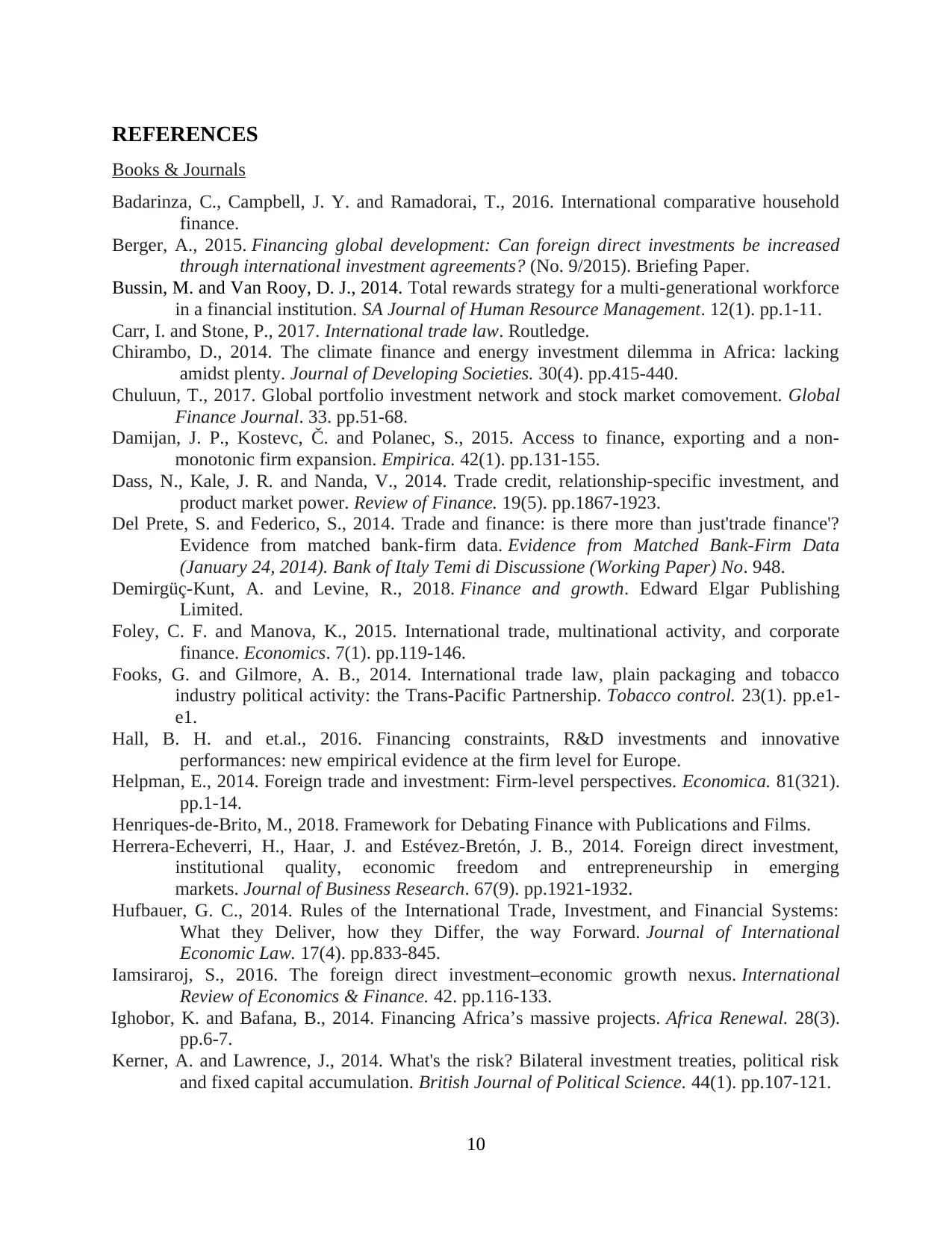
REFERENCES
Books & Journals
Badarinza, C., Campbell, J. Y. and Ramadorai, T., 2016. International comparative household
finance.
Berger, A., 2015. Financing global development: Can foreign direct investments be increased
through international investment agreements? (No. 9/2015). Briefing Paper.
Bussin, M. and Van Rooy, D. J., 2014. Total rewards strategy for a multi-generational workforce
in a financial institution. SA Journal of Human Resource Management. 12(1). pp.1-11.
Carr, I. and Stone, P., 2017. International trade law. Routledge.
Chirambo, D., 2014. The climate finance and energy investment dilemma in Africa: lacking
amidst plenty. Journal of Developing Societies. 30(4). pp.415-440.
Chuluun, T., 2017. Global portfolio investment network and stock market comovement. Global
Finance Journal. 33. pp.51-68.
Damijan, J. P., Kostevc, Č. and Polanec, S., 2015. Access to finance, exporting and a non-
monotonic firm expansion. Empirica. 42(1). pp.131-155.
Dass, N., Kale, J. R. and Nanda, V., 2014. Trade credit, relationship-specific investment, and
product market power. Review of Finance. 19(5). pp.1867-1923.
Del Prete, S. and Federico, S., 2014. Trade and finance: is there more than just'trade finance'?
Evidence from matched bank-firm data. Evidence from Matched Bank-Firm Data
(January 24, 2014). Bank of Italy Temi di Discussione (Working Paper) No. 948.
Demirgüç-Kunt, A. and Levine, R., 2018. Finance and growth. Edward Elgar Publishing
Limited.
Foley, C. F. and Manova, K., 2015. International trade, multinational activity, and corporate
finance. Economics. 7(1). pp.119-146.
Fooks, G. and Gilmore, A. B., 2014. International trade law, plain packaging and tobacco
industry political activity: the Trans-Pacific Partnership. Tobacco control. 23(1). pp.e1-
e1.
Hall, B. H. and et.al., 2016. Financing constraints, R&D investments and innovative
performances: new empirical evidence at the firm level for Europe.
Helpman, E., 2014. Foreign trade and investment: Firm‐level perspectives. Economica. 81(321).
pp.1-14.
Henriques-de-Brito, M., 2018. Framework for Debating Finance with Publications and Films.
Herrera-Echeverri, H., Haar, J. and Estévez-Bretón, J. B., 2014. Foreign direct investment,
institutional quality, economic freedom and entrepreneurship in emerging
markets. Journal of Business Research. 67(9). pp.1921-1932.
Hufbauer, G. C., 2014. Rules of the International Trade, Investment, and Financial Systems:
What they Deliver, how they Differ, the way Forward. Journal of International
Economic Law. 17(4). pp.833-845.
Iamsiraroj, S., 2016. The foreign direct investment–economic growth nexus. International
Review of Economics & Finance. 42. pp.116-133.
Ighobor, K. and Bafana, B., 2014. Financing Africa’s massive projects. Africa Renewal. 28(3).
pp.6-7.
Kerner, A. and Lawrence, J., 2014. What's the risk? Bilateral investment treaties, political risk
and fixed capital accumulation. British Journal of Political Science. 44(1). pp.107-121.
10
Books & Journals
Badarinza, C., Campbell, J. Y. and Ramadorai, T., 2016. International comparative household
finance.
Berger, A., 2015. Financing global development: Can foreign direct investments be increased
through international investment agreements? (No. 9/2015). Briefing Paper.
Bussin, M. and Van Rooy, D. J., 2014. Total rewards strategy for a multi-generational workforce
in a financial institution. SA Journal of Human Resource Management. 12(1). pp.1-11.
Carr, I. and Stone, P., 2017. International trade law. Routledge.
Chirambo, D., 2014. The climate finance and energy investment dilemma in Africa: lacking
amidst plenty. Journal of Developing Societies. 30(4). pp.415-440.
Chuluun, T., 2017. Global portfolio investment network and stock market comovement. Global
Finance Journal. 33. pp.51-68.
Damijan, J. P., Kostevc, Č. and Polanec, S., 2015. Access to finance, exporting and a non-
monotonic firm expansion. Empirica. 42(1). pp.131-155.
Dass, N., Kale, J. R. and Nanda, V., 2014. Trade credit, relationship-specific investment, and
product market power. Review of Finance. 19(5). pp.1867-1923.
Del Prete, S. and Federico, S., 2014. Trade and finance: is there more than just'trade finance'?
Evidence from matched bank-firm data. Evidence from Matched Bank-Firm Data
(January 24, 2014). Bank of Italy Temi di Discussione (Working Paper) No. 948.
Demirgüç-Kunt, A. and Levine, R., 2018. Finance and growth. Edward Elgar Publishing
Limited.
Foley, C. F. and Manova, K., 2015. International trade, multinational activity, and corporate
finance. Economics. 7(1). pp.119-146.
Fooks, G. and Gilmore, A. B., 2014. International trade law, plain packaging and tobacco
industry political activity: the Trans-Pacific Partnership. Tobacco control. 23(1). pp.e1-
e1.
Hall, B. H. and et.al., 2016. Financing constraints, R&D investments and innovative
performances: new empirical evidence at the firm level for Europe.
Helpman, E., 2014. Foreign trade and investment: Firm‐level perspectives. Economica. 81(321).
pp.1-14.
Henriques-de-Brito, M., 2018. Framework for Debating Finance with Publications and Films.
Herrera-Echeverri, H., Haar, J. and Estévez-Bretón, J. B., 2014. Foreign direct investment,
institutional quality, economic freedom and entrepreneurship in emerging
markets. Journal of Business Research. 67(9). pp.1921-1932.
Hufbauer, G. C., 2014. Rules of the International Trade, Investment, and Financial Systems:
What they Deliver, how they Differ, the way Forward. Journal of International
Economic Law. 17(4). pp.833-845.
Iamsiraroj, S., 2016. The foreign direct investment–economic growth nexus. International
Review of Economics & Finance. 42. pp.116-133.
Ighobor, K. and Bafana, B., 2014. Financing Africa’s massive projects. Africa Renewal. 28(3).
pp.6-7.
Kerner, A. and Lawrence, J., 2014. What's the risk? Bilateral investment treaties, political risk
and fixed capital accumulation. British Journal of Political Science. 44(1). pp.107-121.
10
⊘ This is a preview!⊘
Do you want full access?
Subscribe today to unlock all pages.

Trusted by 1+ million students worldwide
1 out of 13
Related Documents
Your All-in-One AI-Powered Toolkit for Academic Success.
+13062052269
info@desklib.com
Available 24*7 on WhatsApp / Email
![[object Object]](/_next/static/media/star-bottom.7253800d.svg)
Unlock your academic potential
Copyright © 2020–2025 A2Z Services. All Rights Reserved. Developed and managed by ZUCOL.



